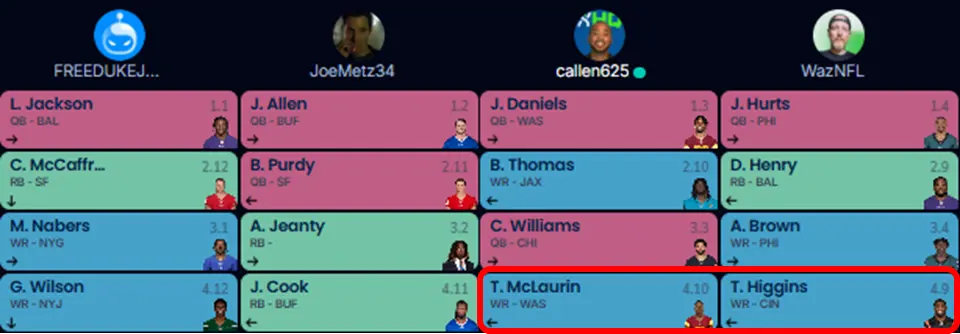
Targets Per Route Run: A Key Metric To Staying One Step Ahead in Fantasy Football
There’s no way that a letter could equal a number.
I vividly remember having this thought during my first introduction to algebra. The memory usually cycles through my mind because when I’m not cosplaying as a writer, I’m an engineer. The irony makes me laugh.
Anyway, back then, the concept of bringing symbols into math was a bridge too far.
It didn’t matter that we had spent weeks on number lines (remember those?) or real-world examples to ease into the subject. I flew through those with ease. The moment I saw an “x,” it was a wrap. It took a few (well, many) nights for the idea to click. Advanced football stats fall into the same bucket.
Like algebra, most of the metrics that the nerds (e.g., me) spout build off of each other. The simpler ones are like building blocks. Stack a couple together, and you get something new, such as targets per route run.
But don’t let the result scare you. If you understand the parts that go into it, the outcome is just as simplistic.
Targets Per Route Run- The Definition
“Targets per route run measures how often a pass catcher earns a target when they are running a route.”
To be honest, this stat didn’t make sense when I first heard about it. My logic? Well, if a receiver is good enough, they should be targeted all the time! I mean, if you think about it, good offenses find all sorts of ways to get the ball to their star players.
Pre-snap motion gets them on the move as early as possible. A shift to the slot can be a cheat code at times, as many defensive units keep their best defenders on the perimeter. RPOs, screens, play-action concepts—you get the idea. Again, my naivete kept me from making the (semi) obvious connection. I’ll let my favorite WRs explain.
Heads up, if there’s a chance for me to use clips from the Bengals’ comeback win over Denver to explain something, I’m going to do it.
Anyway, on both pass attempts, don’t look at Tee Higgins (I did. Multiple times). Watch Ja’Marr Chase.
Hindsight being 20/20, Joe Burrow could’ve tried to thread a throw to his former college teammate. Yes, by two seconds after the snap, the safety is already making a beeline to the left sideline, and Burrow has made his decision to let it fly. Admittedly, choosing Chase wouldn’t have netted the same result. But let’s assume it was possible.
We’ve already established that getting the ball thrown in your direction is a skill. It signals intent. But it’s not just on the pass catcher. As in Chase’s case, he had to compete with some 6’4” dude from Clemson for Burrow’s attention. However, at least he was still involved in the play. In the most critical series of the season, Cincinnati’s best option was on the field. He wasn’t the main character, but he was a key part of the story that kept the Bengals’ hopes alive (for about 12 hours).
So, we’ve got two building blocks here: targets and routes. Or, put another way, intent and involvement. If you bring the two together, you get a rate stat, like targets per route run. By dividing the two simple metrics, we’ve blended a player trait with offensive participation.
Subsequently, we can further contextualize a player’s significance and make comparisons within an offense and across an entire positional group.
Why do Targets per Route Run Matter?
The easiest case to make is by showing a direct connection to fantasy points. A statement like “higher targets per route (TPRR) run means a player will score more points” would be a slam dunk. But again, let’s consider the simple stats that make our advanced one.
Targets have one of the best, if not the strongest, correlations to a pass-catcher’s fantasy output (R2: 0.73). There, we do have a “more is better” scenario.
But remember, routes aren’t as impactful. We’re just looking at how often a receiver gets in their cardio workout. It’s good that they’re out there, but I’m yet to play in a point-per-route-run league (someone should suggest it to Scott Fish). So, if targets do matter and routes aren’t as important, we should expect a metric that combines the two to lag in priority.

An R2 of 0.35 isn’t great. Accordingly, let’s try to reframe how we look at TPRR.
“How often does my player get the ball?”
It’s a common thought. Or, at least, we answer it by checking ADPs. The higher a player’s value, the likelier they’re earning more touches.
However, the question points to production. It assumes a full-time presence on the field and only teammates as competition. But let me tweak the notion a bit.
“What is my player doing during their time on the field?”
Ideally, they’re getting the ball! However, the underlying theme here isn’t productivity like before. It’s efficiency. A single receiver isn’t going to be the focal point of every play. We just watched that happen to Ja’Marr Chase. But a mix between earning opportunities and being on the field is where we can start to make bets on value. I’ll use last season’s Top 5 in TPRR as an example.
- Puka Nacua: 38.3% (TPRR rate)
- Malik Nabers: 30.9%
- Josh Downs: 29.4%
- CeeDee Lamb: 28.9%
- Drake London: 28.9%
One of these things is not like the others. The top two and bottom two are the unquestioned WR1s on their respective offenses. Josh Downs is the Colts’ slot man. He cracked an 80.0% route rate just four times during the regular season. At best, Downs is Michael Pittman’s 1B if hurt (as was the case throughout most of last year). However, he earned 30.0% or more of the targets in five games. It’s why his 29.4% TPRR has him in the running with the top receivers from ’24. And by recognizing the context of the situation and how to calculate the stat, we can use it to find players we can stash on our rosters.
How Can You Use Targets per Route Run?
Let’s establish some thresholds first.
There have been 18 WRs to crest 200 fantasy points in standard-scoring leagues over the last five years. Their TPRRs have ranged from 22.1% to 36.6% (average of 27.9%). So, we can at least agree that a TPRR over 20.0% puts you in the ballpark of a WR1.
However, during any draft, you’ll come to this same scenario.

In our last staff superflex mock, I missed out on Tee Higgins by one pick. I’m not still mad about it. No, really. It’s fine. However, the recurring critique is taking a “team’s WR2” before “someone else’s WR1.” Of course, in this case, Higgins bears top-12 consideration. But there are other duos with the same perception of a significant gap in their workloads. And just a casual glance at TPRRs emphasizes how we can debunk that line of thinking.
- Chicago: Moore (21.1%), Allen (22.3%)
- Cincinnati: Chase (24.8%), Higgins (24.7%)
- Philadelphia: Brown (27.3%), Smith (22.3%)
- Tampa Bay: Evans (22.8%), Godwin (26.8%)
Sure, injury risk and team outlook can play a role in how we value a receiver. However, we can capitalize on the unfounded concern of a lesser role based on a depth chart. Great pass catchers can coexist on the same team. It’s their lesser-skilled teammates who suffer (see Kmet, Cole). So, we can leverage TPRR to make optimal decisions during the draft. Luckily, the utility of the stat extends into the season, too.
Do you remember the Dontayvion Wicks debacle of Week 5?
The week prior, Green Bay’s WR4 had scored two touchdowns. Not only did he find the end zone a couple of times, but Christian Watson and Romeo Doubs were also going to be out against the Rams. Wicks headlined every waiver column. He was the trendy offseason sleeper. The stars were aligning all to give us 20 yards on two catches.
Should we have picked up someone else instead?
Even with the gift of hindsight, I say no. Two starters were out, and the passing volume needed to go somewhere. By comparing the utilization of the Packers’ WRs, Wicks stood out as the best choice given the circumstances.

Green Bay was already indicating they wanted to involve Wicks more. He was forcing Jordan Love to look his way whenever he was running a route. If only we knew that his hands turned into stone when they got into the spotlight.
Regardless, by using TPRR throughout the season, we can find the players with paths to taking on larger workloads if things break in their favor.

